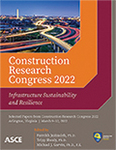Framework for Measuring Infrastructure Vulnerability and Resiliency of Communities during a Flood Disaster
Publication: Construction Research Congress 2022
ABSTRACT
Understanding availability and accessibility of critical infrastructure systems during the pre-disaster phase and evaluating the impact of their possible disruption during the disaster phase are crucial for measuring the vulnerability and resiliency of communities. This study proposes a new quantitative framework for flood risk assessment that helps understand the existing disaster risk and proactively mitigate the impact of infrastructure disruption on communities by systematically analyzing: (1) reliability of a transportation network and (2) vulnerability of residents and critical facilities. The methodology addresses the following infrastructure systems categorized as: (1) distribution-based and (2) facility-based systems. This study has modeled the dependency of the facility-based category on the transportation network and developed a general framework that measures the deficiency in pre-disaster phase and possible disruptions during the disaster response phase. For a cast study, this framework was applied to evaluate the vulnerability and resiliency of emergency facilities in the East Baton Rouge. It was concluded that a detailed analysis of both pre-existing conditions and during disaster conditions along with social vulnerability provide a more realistic insight and more accurate benchmark of vulnerability and resiliency of communities pertaining to infrastructure systems. This framework is expected to improve hazard mitigation and decision-making processes in investments and prioritization of infrastructure improvement projects.
Get full access to this article
View all available purchase options and get full access to this chapter.
REFERENCES
Arboleda, C. A., Abraham, D. M., Richard, J.-P. P., and Lubitz, R. (2006). “Impact of interdependencies between infrastructure systems in the operation of health care facilities during disaster events.” Joint Interanational Conference on Computing and Decision Making in Civil and Building Engineering, Montreal, Canada, 2006.
Bruijn, K. D., Burman, J., Mens, M., Dahm, R., and Klijn, F. (2017). “Resilience in practice: Five principles to enable societies to cope with extreme weather events.” Environ. Sci. Policy 2017, 70, 21–30.
Dorbritz, R. (2011). “Assessing the resilience of transportation systems in case of large-scale disastrous events.” Proc., 8th Int. Conf. on Environmental Engineering, Selected Papers (3), VGTU Press, Vilnius, Lithuania, 1070–1076.
Fekete, A. (2020). “Critical infrastructure and flood resilience: cascading effects beyond water.” Journal of Flood Risk Management, 2020;13:e312600.
Field, C. B., Barros, V., Stocker, T. F., Qin, D., Dokken, D. J., Ebi, K. L., Mastrandrea, M. D., Mach, K. J., Plattner, G.-K., Allen, S. K., Tignor, M., and Midgley, P. M. (2012). “Managing the risks of extreme events and disasters to advance climate change adaptation.” The Intergovernmental Panel on Climate Change (IPCC, 2012). Cambridge, England and New York, NY: Cambridge University Press.
Jenelius, E., and Mattsson, L. G. (2015). “Highway network vulnerability analysis: conceptualization, implementation and application.” Computers Environment & Urban Systems, 49, 136–147.
Hallegatte, S., Green, C., Nicholls, R. J., and Corfee-Morlot, J. (2013). “Future flood losses in major coastal cities.” Nat. Clim. Chang. 2013, 3, 802–806.
Hickford, A. J., Blainey, S. P., Hortelano, A. O., and Pant, R. (2018). “Resilience engineering: theory and practice in interdependent infrastructure systems.” Environment Systems and Decisions, (2018) 38:278–291.
Len, N. L. S., Bolong, N., Rolee, R., Tongkul, F., Mirasa, A. K., and Ayog, J. L. (2018). “Flood vulnerability of critical infrastructure-Review.” Malaysian Journal of Geosciences 2(1), pp. 34–37, 2018.
Murdock, H. J., Bruijn, K. M. D., and Gersonius, B. (2018) “Assessment of critical infrastructure resilience to flooding using a response curve approach.” Sustainability, 10, 3470, 2018.
Murray, A. T., Matisziw, T. C., and Grubesic, T. H. (2007). Critical network infrastructure analysis: Interdiction and system flow. Journal of Geographical Systems, 9(2), 103–117.
Ouyang, M., Dueñas-Osorio, L., and Min, X. (2012). “A three-stage resilience analysis framework for urban infrastructure systems.” Struct. Saf. 2012, 36, 23–31.
Pant, R., Thacker, S., Hall, J. W., Alderson, D., and Barr, S. (2018). “Critical infrastructure impact assessment due to flood exposure.” J. Flood Risk Manag. 2018, 11, 22–33.
Pescaroli, G., and Alexander, D. (2015). “A definition of cascading disasters and cascading effects: Going beyond the “toppling dominos” metaphor.” GRF Davos Planet@Risk, Volume 3, Number 1, Special Issue on the 5th IDRC Davos 2014, March 2015.
Rinalidi, S. M., Peerenboom, J. P., and Kelly, T. (2001). “Identifying, understanding and analyzing critical infrastructure interdependencies.” IEEE Control System Magazine 2001:11–25.
Robert, B., Senay, M. H., Plamondon, M. E. P., and Sabourin, J. P. (2003). “Characterization and ranking of links connecting life support networks.” Public safety and emergency preparedness,2003.
Thieken, A. H., Bessel, T., Kienzler, S., Kreibich, H., Müller, M., Pisi, S., and Schröter, K. (2016). “The flood of June 2013 in Germany: How much do we know about its impacts?” Natural Hazards and Earth System Sciences, 16, 1519–1540.
Information & Authors
Information
Published In
History
Published online: Mar 7, 2022
Authors
Metrics & Citations
Metrics
Citations
Download citation
If you have the appropriate software installed, you can download article citation data to the citation manager of your choice. Simply select your manager software from the list below and click Download.
Cited by
- Anisha Deria, Yong-Cheol Lee, Rubayet Bin Mostafiz, Carol J. Friedland, Measuring Disparity in Flood Risk and Freeboard Benefits for Different Income Groups, Computing in Civil Engineering 2023, 10.1061/9780784485248.016, (127-135), (2024).
